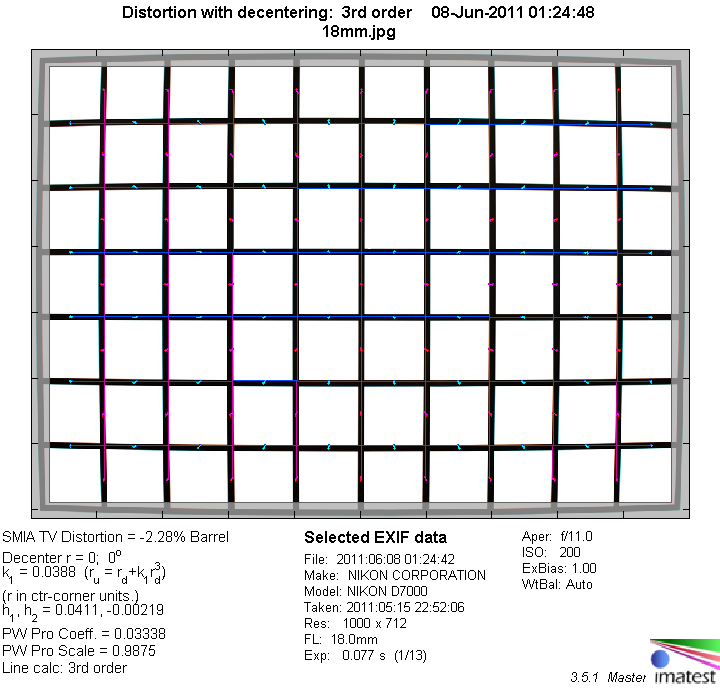|
Sigma AF 18-50mm f/2.8-4.5 DC HSM OS (Nikon) - Review / Test Report - Analysis |
|
Lens Reviews -
Nikon / Nikkor (APS-C)
|
|
Page 2 of 3

Distortion
The Sigma shows typical distortion characteristics for a standard zoom lens. At the wide end, there is quite pronounced barrel distortion. At 24mm, distortion has already switched over to the pincushion type, but the amount is rather low. The pincushion characteristic remains for the rest of the zoom range, the amount increases to around 1 %, though.
|
Move the mouse cursor over the focal length text marks below to observe the respective distortion
|
| 18mm |
24mm |
35mm |
50mm |
|

|
The chart above has a real-world size of about 120x80cm.
Vignetting
In terms of aperture, the Sigma lens is quite fast for a standard zoom at the low end, so it doesn't come as a big suprise that it shows the most vignetting at these settings. With around 1 and 1.3 EV wide open, the light falloff can be disturbing at 18 and 24 mm. Stopping down helps to reduce vignetting to less disturbing values. This is also true for the larger focal lengths, where vignetting is less pronounced wide open and hardly field-relevant stopped down.

MTF (resolution)
The lens produced mixed results in our lab. The center resolution is very high and able to reach excellent figures wide open already or stopped down slightly. The sweet spot of the lens is at 24mm here, towards the longer end of the focal range the resolution drops a bit, but remains on a very high level.
Borders and corners are a very different story, though. At 18mm, they are quite soft and even stopping down significantly does not produce good values. At 24mm, the situation is similar wide open, but stopping down to f/8 helps to produce good resolution in the corners and even very good sharpness at the borders.
From 35mm onwards, borders and corners deliver a lot better sharpness, reaching good to very good resolution figures.
Please note that the MTF results are not directly comparable across the different systems!
Below is a simplified summary of the formal findings. The chart shows line widths per picture height (LW/PH) which can be taken as a measure for sharpness.
If you want to know more about the MTF50 figures you may check out the corresponding Imatest Explanations

Chromatic Aberrations (CAs)
Just like MTF, CAs (color shadows at harsh contrast transitions) show a mixed behaviour depending on the focal length. With values up to 2.6 pixels (18 mm) and around 1.5 pixels (24 mm) at the image borders they can be visible and disturbing at the lower focal lengths. At 35mm they are hardly field-relevant, but increase again towards the long end of the focal range.
However, please note that CAs can easily be corrected in software or by the camera itself (most modern Nikon DSLRs remove CAs themselves if you shoot JPGs).

|